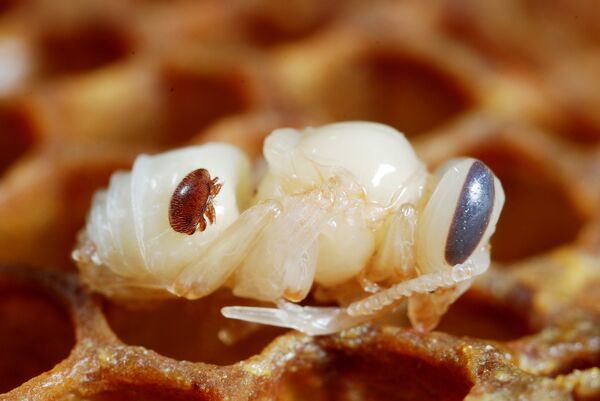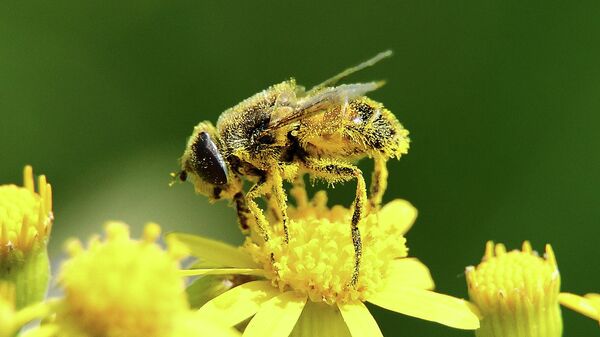An annual survey of 5,000 beekeepers in the US reported a loss of 42% of their honeybee colonies, up considerably from the 35% loss reported during the same period in both 2014 and 2013. The survey, by The Bee Informed Partnership, has surveyed winter losses to colonies since 2006 but has only gathered information on summer and total losses since 2010.
Commercial beekeepers were hit particularly hard, but the most surprising finding was that bee deaths rose last summer, and actually exceeded deaths during the winter months, a new a worrying development.
"We expect the colonies to die during the winter, because that’s a stressful season," said Dennis vanEngelsdorp, an assistant entomology professor at the University of Maryland and director of the partnership told the New York Times. "What’s totally shocking to me is that the losses in summer, which should be paradise for bees, exceeded the winter losses."

There are an estimated 2.74 million managed honeybee colonies in the United States. The sample surveyed by Bee Informed, which is a partnership among various universities and research organizations, represents about 14.5% of the nation's total.
Bloodsucking Bugs, Poison Pesticides Just Two Theories Behind Collapse
Beekeepers first noticed a rise in the deaths of their bees in the mid 1990s, but it didn't come to widespread attention until the middle of the last decade. While it's normal to see about 10% of colonies die off in a given year, suddenly beekeepers were losing much more, and it was happening across the country.
The phenomenon was dubbed "colony collapse disorder" and in 2013 the highest rate of bee deaths was recorded when 45% of colonies were lost.
— Anonymous 4thEstate (@4thAnon) April 24, 2015
Though no one cause has been identified with certainty, scientists have studied various factors that may be contributing.
Scientists like vanEngelsdorp are focusing on a few problems they believe are the most important factors: the varroa mite, pesticides, poor nutrition and possible fungal or viral infections.
The varroa mite — which vanEngelsdorp told Time magazine was the one he'd tackle first — fits the timeline of collapse as it only came to the US in the 1980s. The little mites basically latch on to a honey bee and suck its blood, spreading easily within and among colonies.

Pesticides have also been the subject of much scientific scrutiny, and there is evidence that a class of pesticides called neonicotinoids are harming bee populations. A study from Harvard in 2014 found that neonicotinoids have "sub-lethal" effects on bees, and the European Union has placed a temporary 2-year ban on some neonicotinoids out of caution.
A pair of recent studies shed worrying light on the potential for harm from neonicotinoids. The first studied fields of canola in Sweden — some prayed with neonicotinoids, some not — and found that bumblebees and wild bees, not the honeybees scientists usually study, had slower colony growth and breeding among solitary females dropped.
— Brian Banks (@BrianBanks) April 4, 2015
The second study compounds the concern, as it found that bees actually seem to prefer plants sprayed with neonicotinoids, in a sort of chemical parallel to the way nicotine affects the human brain.
"The fact that bees show a preference for food containing neonicotinoids is concerning as it suggests that like nicotine, neonicotinoids may act like a drug to make foods containing these substances more rewarding," lead author Geraldine Wright wrote in a statement.
The studies are worrying, but so far, scientists have not been able to definitely conclude that they are having the widespread effect out in fields that is causing colony collapse. Though no ban similar to the one in Europe is in the works in the US, Lowe's stores have decided to stop selling the products on their own initiative.
— H. I. Moses (@himoses73) May 11, 2015
Aside from blood-sucking mites and poison pesticides, bees may also suffer from poor diets.
"Bees need a varied diet of different pollens in order to grow into strong, healthy workers," Dr. Heather Mattila, a biologist at Wellesley College told Time. And industrial agriculture creates anything but a varied environment.
Some beekeepers split their colonies up over different areas or supplement bees' nutrition. Farmers who have started to plant wildflowers in unused patches of land can also help. "A green space can be a green desert if it doesn’t have flowering plants that are bee-friendly," Mattila explains.
But maybe the problem is the tobacco ringspot virus, which as Scientific American reported in January, made the improbable leap from infecting plants to infecting honeybees that pollinate them. The honeybee just can't seem to catch a break.
— Dr. Joseph Mercola (@mercola) March 17, 2015
Amid all the hypotheses, and even as the collapses worsen, bee die-offs evolve continue to evolve in disturbing new ways that surpass our understanding. In an ominous development, queen bees have started to have much shorter life spans.
"When I started working with bees 18 years ago, we’d replace living queens every two years," Mattila told Time. "Now queens die after half a summer. Nobody is really clear on why."


